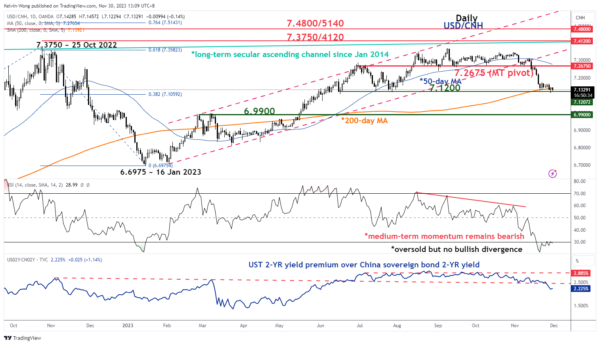- November NBS Manufacturing & Non-Manufacturing PMIs for China came in weaker than expected.
- Recurring risk of the deflationary spiral in China has led to the underperformance of China & Hong Kong stock markets despite the recent bout of global risk-on-herding behaviour.
- The Chinese yuan has continued to appreciate against the US dollar driven by external factors; an increasing expectation of a dovish Fed pivot to come in Q1 2024.
- Watch the key medium-term resistance of 7.2675 on the USD/CNH (offshore yuan).
The November NBS Manufacturing PMI for China has remained a contractionary state; it declined to 49.4 from 49.5 in October and below the consensus estimate of 49.7. This observation suggests a weak external demand environment coupled with the ongoing dismantling of global manufacturing supply chains especially in the semiconductor industry due to the rivalry between the US and China in the high-tech Internet of Things space.
Even though the services sector has continued to record growth for the 11th consecutive month, the NBS Non-Manufacturing PMI for November came in at 50.2, down from 50.6 recorded in October; its weakest expansion so far in the past 11 months.
Also, new export orders sub-component data of the NBS Non-Manufacturing PMI continued to contract deeper in November from a month earlier; 46.8 versus. 49.1.
All in all, the latest spate of lackluster key economic data and the ongoing depressed property market in China have allowed the deflationary spiral narrative to resurface again despite recently implemented targeted fiscal and monetary stimulus measures to alleviate the current severe liquidity crunch faced by China’s property developers.
One of the latest indirect monetary stimulus measures in the pipeline could potentially involve China state-owned banks providing short-term unsecured loans for the first time to qualified property developers. This measure does not seem to gel well in terms of positive sentiment for the Chinese stock market as it increases moral hazard risk in the financial system as well as erodes banks’ profit margins.
China & and Hong Kong stock markets continued their persistent underperformance
China’s key benchmark stock indices and its proxies have continued to underperform month-to-date for November despite a broad-based risk-on-herding behaviour that has taken shape for the rest of the world since late October 2023 due to a weakening US dollar trend.
The CSI 300 recorded a monthly loss of -2.12% for the month of November together with similar weakness seen in the Hang Seng Index (-0.51%), Hang Seng China Enterprises Index (-0.33%), and Hang Seng TECH Index (+3.44%) that underperformed the iShares MSCI All-Country World ETF (+8.61%) over the same period.
Yuan bulls remain resilient despite weakness in China stock market
Fig 1: USD/CNH medium-term trend as of 30 Nov 2023 (Source: TradingView, click to enlarge chart)
The offshore yuan (CNH) has appreciated by +3.5% against the US dollar since 8 September 2023 and the primary catalyst is more external rather than domestic driven.
The recent yuan strength has been attributed to increasing expectations of a Fed Pivot to kickstart an interest rate cut cycle to come as soon as March next year.
Based on the current calculations from CME FedWatch Tool at this time of the writing, it has shown a 46% chance of a 25 basis points (bps) cut on the Fed Funds rate during the 20 March 2024 FOMC meeting.
This latest bout of dovish expectations on the Fed being priced by market participants has led to a significant shrinkage of the 2-year yield premium between the US Treasury note and China sovereign bond; the 2-year US Treasury note/China sovereign yield spread has dropped by -65 bps from its August 2023 print of 2.97%.
Also, the latest observation from a technical analysis perspective suggests that the yuan may continue to strengthen from a multi-week perspective as the medium-term downside momentum remains bearish for the USD/CNH (offshore yuan) foreign exchange rate as indicated by the latest reading of its daily RSI momentum indicator and trend analysis via the breakdown of its former medium-term ascending channel from 16 January 2023 low.
The USD/CNH now looks vulnerable to a further potential decline, a break below its near-term support of 7.1200 (also the key 200-day moving average) exposes the next medium-term support of 6.9900.
Only a clearance with a daily close above the 7.2675 medium-term pivotal resistance (also the downward-sloping 50-day moving average) ignites a potential medium-term bullish revival in the US dollar to see the major resistance zone coming in at 7.3750/4120 on the USD/CNH.













